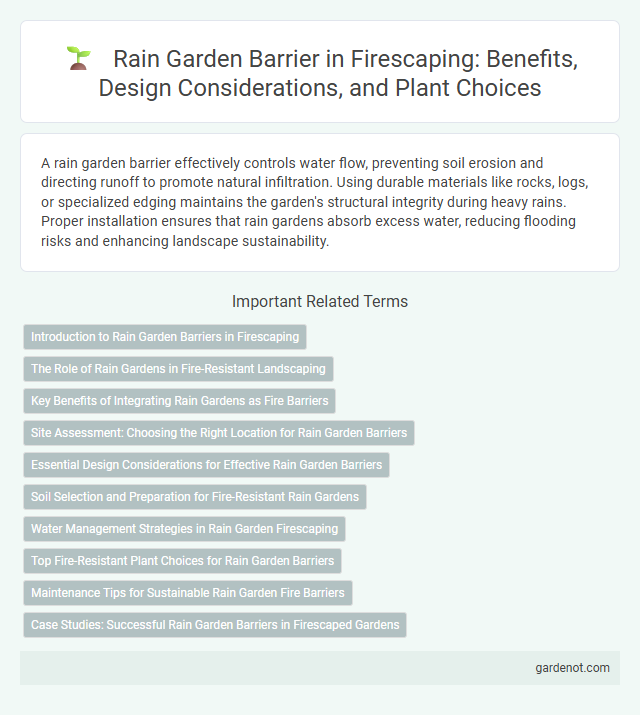A rain garden barrier effectively controls water flow, preventing soil erosion and directing runoff to promote natural infiltration. Using durable materials like rocks, logs, or specialized edging maintains the garden's structural integrity during heavy rains. Proper installation ensures that rain gardens absorb excess water, reducing flooding risks and enhancing landscape sustainability.
Introduction to Rain Garden Barriers in Firescaping
Rain garden barriers play a crucial role in firescaping by preventing wildfire embers from igniting vegetation within rain gardens, which often contain flammable plants and organic mulch. These barriers are designed to withstand high temperatures and block ember intrusion, helping to maintain the garden's fire-resistant function while managing stormwater runoff effectively. Incorporating fire-resistant materials like stone, metal edging, or gravel barriers enhances safety by creating defensible spaces and reducing fuel load near structures.
The Role of Rain Gardens in Fire-Resistant Landscaping
Rain gardens act as vital components in fire-resistant landscaping by serving as natural barriers that retain and slow water runoff, reducing the likelihood of ignition near structures. Their strategic placement minimizes dry fuel accumulation and supports moisture-retentive vegetation, enhancing overall landscape resilience during wildfire events. Incorporating rain gardens into defensible space planning boosts ecosystem health and acts as an effective buffer against fire spread, protecting properties without compromising aesthetics.
Key Benefits of Integrating Rain Gardens as Fire Barriers
Rain garden barriers significantly enhance fire resilience by creating moist, low-flammability zones that slow wildfire spread near properties. These sustainable landscapes improve soil absorption and reduce runoff, mitigating erosion while supporting fire-resistant native plants. Integrating rain gardens as fire barriers not only protects homes but also promotes biodiversity and water conservation in fire-prone areas.
Site Assessment: Choosing the Right Location for Rain Garden Barriers
Selecting the ideal site for rain garden barriers requires thorough site assessment, focusing on soil permeability, slope, and drainage patterns to prevent water accumulation near structures. Identifying low-lying areas prone to runoff enhances barrier effectiveness by directing excess water into the rain garden. Proper placement based on these environmental factors maximizes fire resistance while supporting water management and landscape health.
Essential Design Considerations for Effective Rain Garden Barriers
Rain garden barriers require permeable materials to maintain proper water infiltration while preventing soil erosion and managing runoff effectively. Choosing the right height and depth helps contain mulch and plant roots, ensuring stability without obstructing water flow. Proper placement around inflow and outflow zones enhances filtration and protects the garden from excessive sediment accumulation.
Soil Selection and Preparation for Fire-Resistant Rain Gardens
Selecting well-draining, fire-resistant soil mixtures rich in sand and gravel enhances rain garden resilience in fire-prone areas. Preparing the soil by integrating organic matter like compost improves moisture retention while reducing flammability within the garden bed. Proper soil composition supports healthy plant growth and acts as a natural barrier to inhibit fire spread in firescaping designs.
Water Management Strategies in Rain Garden Firescaping
Rain garden barriers play a critical role in firescaping by enhancing water management strategies that mitigate wildfire risks. These barriers help control runoff, prevent soil erosion, and improve infiltration, ensuring that rain gardens retain moisture essential for fire-resistant vegetation. Integrating permeable berms or natural stone edging supports sustainable water flow, reducing fire hazards while promoting ecological balance.
Top Fire-Resistant Plant Choices for Rain Garden Barriers
Top fire-resistant plant choices for rain garden barriers include California lilac (Ceanothus spp.), manzanita (Arctostaphylos spp.), and succulents like sedum and agave, which have high moisture content and low flammability. These plants help create effective living firebreaks by reducing fuel load and maintaining soil stability during wildfires. Incorporating drought-tolerant, fire-resistant species in rain garden barriers enhances landscape resilience while supporting water retention and erosion control.
Maintenance Tips for Sustainable Rain Garden Fire Barriers
Regularly removing debris and dead plant material prevents clogging in rain garden fire barriers, ensuring optimal water infiltration and fire resistance. Inspecting soil compaction periodically maintains proper drainage, which supports healthy vegetation growth and reduces fire hazards. Applying mulch conserves moisture and suppresses weeds, enhancing the longevity and effectiveness of sustainable rain garden barriers.
Case Studies: Successful Rain Garden Barriers in Firescaped Gardens
Case studies of rain garden barriers in firescaped gardens demonstrate their effectiveness in mitigating wildfire risks by controlling water runoff and reducing soil erosion. Successful installations in California and Australia show that using fire-resistant plants combined with permeable barriers enhances garden resilience while maintaining ecological health. These projects highlight that integrating rain garden barriers with fire-resistant landscaping materials significantly improves fire mitigation outcomes in vulnerable areas.
Rain garden barrier Infographic

 gardenot.com
gardenot.com